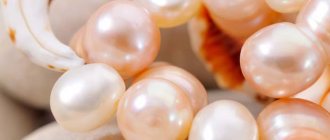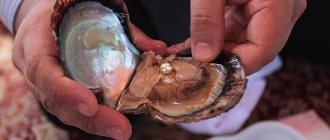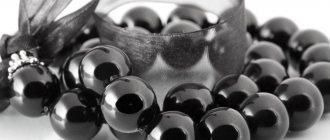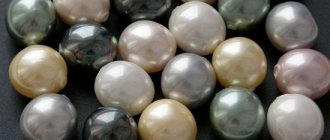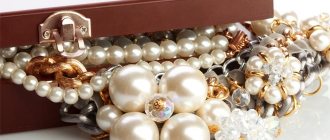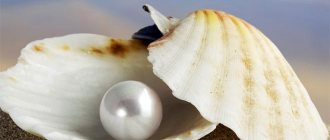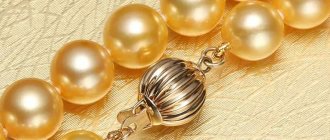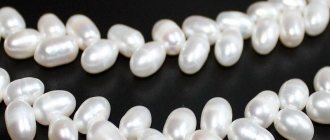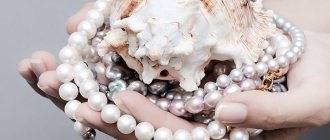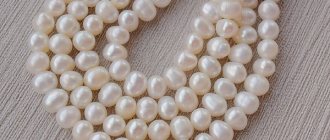Story
People have known what pearls are since ancient times. It has long been found in the shells of marine and freshwater mollusks. This stone is the most ancient jewel on our planet.
It is believed that it was first discovered by accident while catching edible bivalves. Scientists believe that this happened in the waters of the Gulf of Mannar about 4,000 years ago .
The gem began to be used as jewelry and even as a monetary equivalent.
He was highly valued in the East - from China to North Africa, and was adored by the queens of ancient times - Semiramis, Cleopatra and others. The importance of pearls was so great at that time that Cleopatra considered earrings with two large pearls the most valuable of her jewelry.
This stone was highly valued in countries with access to the sea. They decorated statues of gods and heroes and were awarded for military exploits.
On the famous Monomakh's hat, pearls shimmer softly among other gems, and it is crowned with a cross with pearls.
Since the Middle Ages, these stones have been used to decorate crosses, icons, and robes of clergy, since among Christians pearls are a symbol of infallibility and purity.
The Russian word “pearl” comes from the Chinese name for this stone - “zhen zhu”. In Rus' it appeared through the Volga-Bulgar and ancient Turkic languages.
In most European languages, the name of this gem has the Latin root perl. It comes from a now unused word that denoted a specific type of mollusk.
In Russian, nacre is the outer coating of pearls.
Vietnam: how pearls are mined
The first farmlands in the countries of Southeast Asia, including Vietnam, began to appear at the beginning of the 20th century. These are large-scale “fields” where shellfish are grown in the thousands using special nets on fixed floating buoys. Thanks to this organization, pearl mining has become simplified and accelerated thousands of times. To get to the shellfish, it is now enough to swim to the signs on a boat, lift the net to the surface and evaluate the catch.
For convenience, the workers of the floating plantations live here, around the field. They raise young mollusks and place them in simulated “beds.” They are also responsible for the most important stage in the process of pearl formation on the farm.
A classic pearl culture farm looks like this: plastic float containers with decking support the utility rooms and workers’ sleeping quarters. In the middle there is a “kindergarten” for shellfish. A variety of oyster species live in it, including those that “bear” elite large beads and those that specialize in small pearls, but spend less time on it. Mother-of-pearl balls of various colors and shades are mined:
- black;
- yellow;
- white;
- green;
- blue, etc.
Blue pearls are considered rare on Vietnamese farms. They are more expensive than others and are highly valued.
At the time of harvesting, workers collect “ripe” shells and bring them to household premises for cleaning of fouling and debris, and then opening them. They work under the supervision of surveillance cameras and security.
All of the above are important technical points, essentially identical to those that accompanied the work of Japanese ama divers. The main difference between a pearl farm is the grafting of the mollusk. This is the operation without which it is useless to count on a fruitful harvest.
“Inserting” a foreign body into the mantle of a mollusk, thereby provoking the start of the process of creating a pearl, was invented by the Japanese Mikimoto at the end of the 19th century. The main difficulty of the method is that even after the intervention, the oyster must remain alive and not reject the introduced object. To “infect” the valves of each shell on the farm, they are forced to carefully open it so as not to tear the muscles holding them in place, and a small pearlescent ball is inserted into the mantle or gonad.
“Pregnant” shells are taken to a “pearl” plantation, placed in a pen in the South China Sea (the Vietnamese themselves believe that they get pearls in the Indian Ocean), where they live and develop in natural conditions.
Pearls grown in such conditions are as natural as natural ones, which is why their price is quite high. Still found in the world of luxury jewelry, wild pearls are incredibly expensive and are mostly sold to private collections at auctions. The price of cultured pearls averages from several hundred to several thousand dollars per string. It all depends on the quality of the pearls, the diameter of the product, and the color.
Origin
Pearl is a stone of organic origin. Scientists do not consider it a mineral, but according to a long tradition it is classified as a precious stone.
Pearls are formed in the organisms of freshwater and marine mollusks. Sometimes grains of sand, shell fragments and other foreign objects get into sinks. If they come into contact with the mollusk's mantle (the soft shell that hides under the shell), the mollusk covers them with a layer of material that makes up its shell. This is how pearls are formed.
Sometimes several dozen pearls of various shapes are formed in the shell. But the greater their number, the smaller they are.
Only pearls that have a mother-of-pearl shell are valuable.
Pearls are found inside only some bivalves and gastropods, as well as the cephalopod nautilus. But zoologists believe that all types of mollusks can produce them.
How to distinguish real from fake
Since pearls are a rare stone, they are actively imitated. There are different types of fakes, but it’s not difficult to check them even on your own. Evaluate the color, appearance, weight and surface cleanliness of the pearl product:
- Natural stone is heavier than artificial stone. Inside the natural mineral there is mother of pearl, while in a fake product the core is made of plastic or other light artificial material.
- A real mineral has a uniform shine. It is easy to identify a fake by the presence of dullness or uneven shine.
Additional verification methods:
- If you have individual pearls in your hands, do a simple test - you need to drop a pebble from a height of half a meter. When struck, a real mineral bounces back like a ball. The artificial stone will roll across the floor.
- Rub the pearls against each other with little force. There will be scratches and small particles of powder on your fingers. They are easy to remove; just wipe the surface of the pearl with your palm.
- Place the suspect material in acetone. The fake will begin to dissolve in it.
- To ensure the authenticity of the purchased stone, it is better to visit a jeweler who will accurately determine the authenticity.
Physicochemical characteristics
From the point of view of chemists, pearls are a composite of an inorganic substance (calcium carbonate) and an organic substance (conchiolin, a horny substance produced by the mollusk).
- The chemical formula is CaCO3 .
- Color - white, silver, yellowish, golden, blue, cream, green, pink, gray, black.
- The shine is pearlescent.
- Transparency ranges from translucent to opaque.
- Hardness - 3–4.
- Density - 2.6–2.78 g / cm3 .
The structure of the stone is layered.
Soluble even in weak acids.
WHERE DID THE RUSSIAN PEARLS DISAPPEAR?
In the 18th century, the margaritana population in Russia began to decline sharply, and pearl production decreased. Among the reasons were:
- predatory method of obtaining shells;
- river pollution and waterlogging;
- general deterioration of the environmental situation.
To save shellfish from extermination, in 1721 Emperor Peter I issued a decree to streamline pearl mining in Russia. The collection of mother-of-pearl was prohibited for private individuals. Only holders of state permits could engage in mining.
About ten years later, the right to harvest pearls was returned to private owners. True, they could only keep small stones for themselves; large stones had to be handed over to the treasury for a reward. And in 1764, already in the era of Catherine II, the ban on pearl mining in Russia was completely lifted.
The consequences were not long in coming - by 1860, the fishery began to decline, and the production and export of pearls decreased significantly. They tried to revive the industry, but all the measures being developed did not bring tangible results.
We recommend: ALL ABOUT PEARLS: origin and amazing properties
When Russia plunged into an era of coups and revolutions, everyone had no time for gems. After 1917, pearl fishing in the country was considered completely unprofitable.
Mining locations
Pearls are obtained from the shells of marine and freshwater mollusks, more often bivalves (mussels, etc.).
Sea “wild” pearls are found in:
- Persian Gulf;
- Gulf of Mannar;
- Red Sea.
For warm countries washed by the ocean or sea, the profession of pearl diver was traditional. But it is associated with a risk to life, which is why shellfish plantations are now being cultivated in many countries.
There are pearl plantations:
- off the coast of Japan and in some lakes of this country;
- in Burma (in the Bay of Bengal and the Andaman Sea). Burmese pearl is one of the best in the world.
Cultured pearls are no different from wild ones. The core of the future pearl is simply placed into the shell by specialists. After this, under their supervision, the invertebrate grows (and grows the pearl) for several years.
The largest jewel found in a mollusk shell is the “Pearl of Allah.” Its weight is 6.5 kg , and the weight of the mollusk is 300 kg . This jewel has an oblong shape and impressive dimensions - 24 x 16 cm .
Pearl is also found in clean, large rivers of Europe, Asia, and North America. Freshwater pearls are mined in:
- Russia;
- Germany;
- China;
- USA.
Interesting fact. One day, a South Korean resident bought pearl shells for a traditional Korean dish for 60 cents In one of the shells he discovered a rare black pearl with a diameter of 1.5 cm . It was valued at $60,000 .
Pearl fishing
Humanity has been engaged in pearl fishing for hundreds, or even thousands of years. To get just a few pearls, divers had to open a huge number of mollusk shells.
This is interesting!
According to scientists, humanity discovered the first pearls completely by accident. This happened about 4 thousand years ago, when fishermen caught a large “harvest” of edible bivalves in the Gulf of Manara. They did this solely to replenish their provisions. The pearls found in the shells amazed the fishermen with their beauty. Other people also learned about the unusual find. Within a few years, pearl mining became targeted and popular. This rapid development of events is due to the fact that pearls do not need to be processed and they immediately began to be used as jewelry.
Today, the main suppliers of pearls are the Persian Gulf and the Red Sea. Pearls are also mined off the coast of Sri Lanka, as well as in Japan, where this is done by ama (“man of the sea”) - divers (mostly ladies) hunting for algae and mollusk shells. The countries of North America, China, Germany and Russia can boast of the presence of freshwater pearls.
Pearls can be grown artificially. In this case, it is called cultivated. The process of pearl cultivation occurs as follows:
- An oyster that is three years old is carefully opened and a foreign body is placed inside the shell.
- The mollusk is returned to its familiar environment in which it grows the pearl.
- The whole process takes about 2-3 years and is completely controlled.
This is interesting!
The pearl plantation appeared at the end of the 19th century at the instigation of Kokichi Mikimoto, who in 1983 grew his first semicircular pearl. After 1.5 decades, the Japanese patented his technology and made it world famous.
Until now, the main supplier of cultured pearls is Japan. There are pearl nurseries both in the seas and oceans near its shores, and in lakes inland.
Colors and varieties
The color of pearls varies: from white to light shades of pink, green, blue, and gold. There are gray, silver, rich green, black pearls.
The surface of the pearls only seems smooth. It is wavy, inhomogeneous, and light interferes with it. Therefore, on the pearl you can observe the play of color - from light yellow to pink and blue.
The color and shape of pearls depend on the type of shellfish, purity, salinity and temperature of the water.
Types of natural pearls:
- River - small (diameter - up to 7 mm ). White, yellowish, cream, grayish. Shape - from spherical to elliptical.
- “King” is large ( up to 22 mm ), with a thick layer of mother-of-pearl. Colors are different. Found in the southern seas.
- "Mabe" is very large. The shape is perfectly round. The color range is from silver to black.
Types of cultured pearls:
- "Tahiti" - medium size - up to 12 mm in diameter. Gray range - from silver to black.
- “Akoya” is larger (diameter up to 14 mm ). Coloring in all colors except blue.
- "Kasumi" - Japanese pearls. Exotic color - from golden to purple.
Among the natural and cultivated gems, the following varieties are found:
- “Baroque” (baroque pearls) - characterized by irregular shapes. Small, up to 5 mm . Different shades: gray, white, cream.
- “Paragons” are unique pearls that resemble the silhouettes of a person, animal, or plant.
In addition to natural and cultured pearls, there are also artificial pearls - artificially grown or synthesized mother-of-pearl stones. They are always perfectly spherical.
Fresh water production
Mining of the freshwater mineral mainly comes from:
- USA;
- Germany;
- England;
- China;
- some northern rivers of Russia.
Freshwater pearls are characterized by their small size and non-standard shape. It is dimmer than sea, but is particularly durable and reliable. The color palette is dominated by pink or grayish color with a matte pearlescent tint.
Medicinal properties
Pearls have an interesting feature - they fade or change color and thereby signal health problems of their owner.
This change in the appearance of the stone occurs if the owner’s skin acidity increases. Thus, the diagnostic properties of the pebble indicate that an unfavorable process has begun in the body. In this case, it is better to consult a doctor to check the whole body.
The healing properties of pearls should be used in combination with treatment prescribed by the attending physician.
Lithotherapists believe that this gem helps with:
- stomach diseases associated with changes in acidity;
- problems with the liver, kidneys, and, to a lesser extent, with the intestines;
- eye diseases (helps reduce the amount of discharge due to conjunctivitis and other eye diseases).
The following healing powers are attributed to him:
- Regulates the nervous system.
- Improves memory.
- Supports immunity.
- Normalizes blood pressure.
Tibetans hold a pearl in their mouth to cleanse the blood - every day for 15 minutes .
It is believed that pearl water can cleanse the body: you need to put pearls in the water for 12 hours and drink it throughout the day . The healing properties of such water are effective only for one day .
When is it better not to wear it?
When choosing, they are guided by the zodiac sign and character traits.
The stones suit a strong spirit. The weak-willed cause disappointment, even aggression. Therefore, among those who should not wear pearls are dependent people who react to every judgment and lonely people. But love relationships, marriage strengthens.
It is undesirable for a young girl to wear black pearls - this is an attribute of sadness that provokes widowhood. Thanks to this color, it is easier for divorced people or widows to find a match.
A stone of different colors reveals character traits that the owner would like to hide. Therefore, it is dangerous for a low person, no matter what sign he belongs to.
In a house where passions run high, pearls will bring peace. The attentive owner will be warned of impending health dangers. You can contemplate its mysterious overtones. Everyone will find theirs in the precious gift of the sea element.
Magic properties
Among different nations, pearls are a symbol of purity, purity of soul and thoughts.
He favors only sincere people with a pure soul and does not help those who are deceitful and treacherous.
The meaning of pearls for a person is many-sided: this stone symbolizes longevity, fertility, material independence, and the strength of marriage bonds.
Talismans and amulets
The magical properties of pearls were valued by ancient Roman emperors. They believed that talismans made from it strengthen power and make a person wiser.
Now it is believed that pearl talismans are more suitable for women, enhancing the gentleness of their character and maternal wisdom.
In Asian countries, pearl jewelry is traditionally used as amulets. They believe that if bad thoughts and intentions of other people are directed at the owner, the stone will darken and lose its color.
Other properties of pearl amulets:
- They relieve you from the torment of unrequited love.
- Help restore good relationships with others.
- Protect your home from thieves.
- Reduce the likelihood of losses when making business transactions.
- Helps avoid mood swings.
- Reduce and neutralize anxiety, helping to calmly perceive the environment.
For pearls to act as a talisman or amulet, you do not need to perform complex rituals. Just admiring the pearls is enough. The overflows on their surface pacify, calm a person, and harmonize feelings.
Contraindications
The magical properties of pearls are such that this gem is not suitable for anyone.
The magic of mother-of-pearl jewelry is dangerous both for arrogant, vain people who cherish their pride, and for the weak-willed, prone to depression, and having problems with self-esteem.
As a talisman or talisman, pearls are suitable mainly for women. If a man wears such jewelry, then traits of a feminine character may be transferred to him.
But such traits of a woman as flexibility and plasticity can be useful for businessmen and politicians. It is believed that pearls are useful for such people: they bring good luck and protect them from dangers.
Products with pearls are contraindicated for men with unstable psyches, especially creative people. They can lead to personality disorder.
These gems are not recommended to be passed on by inheritance or bought secondhand. They keep within themselves for a long time the emotional and energetic cast of the previous owner. The problems of this person can be transferred to a new owner.
If you like pearls and they are suitable as a talisman or amulet for you, it is better to buy a “pure” example that has never been worn before.
The magic of water stone
The main direction of the magical power of pearls is protection and warning. The gem is able to avert impending disaster by warning the owner about it. The stone darkens, loses color and shine if a person is in danger, damage, or an envious eye.
It is worth noting that pearls are selective - the gem does not tolerate deceit, treachery, waywardness, excessive pride, or anger. The owner of the stone can only be a sincere person, pure in soul and thoughts, capable of keeping his word given to people or to himself.
Since ancient times, pearls have been considered a stone that protects a person from old age, giving eternal youth and beauty. One of the legends tells about Queen Cleopatra - the ruler of Egypt had the habit of drinking pomegranate juice every day, which contained a pearl. This ritual is associated with the unfading youth and beauty of a woman. The action of the drink was supported by all kinds of pearl jewelry, with which Cleopatra daily complemented her royal image.
Also read: Ammolite - a symbol of abundance and prosperity
In ancient times, there was also a custom to give the bride a string of pearls. This was done by the groom himself or his relatives at the wedding ceremony. It was believed that such a gift protected the young wife from infidelity or other actions that could discredit the honor of the family.
Important! Pearl jewelry cannot be passed on by inheritance, since the gem is capable of remembering and storing all the negativity of the previous owner. If you take your grandmother’s necklace as a gift, there is a risk that you will receive all the life problems of your beloved relative along with it.
Pearls generally suit a small circle of people. Among the contraindications are:
- weak will;
- tendency to lose self-control;
- tendency to depression, apathy and other similar conditions.
It is especially undesirable for men with self-esteem problems and weak psyches to acquire pearls.
The magic of the stone is exclusively female. She endows the representative of the fair half of humanity with the necessary qualities - femininity, softness, charm, wisdom. Men who wear pearls run the risk of acquiring such character traits.
This can be useful, even necessary, for politicians or businessmen who need some flexibility and plasticity when conducting negotiations. The stone is strictly prohibited for creative individuals with unstable psyches, since a tandem with a gem will drive them to the point of losing their minds.
Who is suitable according to their zodiac sign?
Astrologers believe that pearls are not suitable for all people. He has the greatest compatibility (but not ideal) with representatives of the zodiac signs, which are protected by the water element.
Zodiac signs of the element Water
- Cancer. According to the horoscope, it is compatible with the energy of pearls. The gem will bring peace of mind and distract you from sad thoughts. It is useful for Cancer to often look at a mother-of-pearl stone.
If you notice that after communicating with a gem, sadness does not go away, it is better to take a break and put the jewelry in the box. Otherwise, pearls can lead to depression.
- Scorpion. Pearls are suitable for this zodiac sign, but only black ones. You only need to wear it occasionally. Black pearls will help Scorpio shine with intelligence. But the strong energy of this sign can destroy the energy of the stone, and then many problems will arise in love, business, and everyday life.
- Fish. A mother-of-pearl gem is ideal for this zodiac sign. A talisman or simply a decoration made from it will promote prosperity, longevity, and bring happiness. The ability to foresee the future will appear. A pearl amulet will protect you from rash actions, the “evil eye,” and the torments of unrequited love. The ring will protect Pisces from thieves and dubious transactions.
Zodiac signs of the element of Fire
- A lion. Its solar energy is not compatible with the lunar energy of pearls. But sometimes you can wear expensive varieties of this stone in order to reduce your temper and gain protection from ill-wishers.
- Aries. He can also wear expensive pearl jewelry if he wants to become more reasonable. But at work it is not appropriate - otherwise the owner will be annoyed by everything.
- Sagittarius. If you want to extend the “white” streak in life, you can wear pearls. But not all types are suitable; you need to find the right energy type.
Air element zodiac signs
They can wear such jewelry, but with caution and not for long.
- Twins. The stone may suit them at first. But the longer you wear it, the more the incompatibility of the energies of the sign and the gem will worsen.
- Scales. If a person's thoughts are pure, pearls can give confidence. But you can't wear it often.
- Aquarius, under the influence of the stone, will gain the ability to solve mysteries, see the past and foresee the future. But if you wear it often, apathy and isolation may appear.
Earth element zodiac signs
Taurus, Virgo, Capricorn. People born under these constellations are not recommended to wear pearls. He can suppress their will, undermine their health and cause discord in the family.
Howlite and chrysoberyl are ideal for these signs.
For Virgo and Taurus, we can also recommend carnelian and labradorite as a talisman.
The serpentine is suitable for Virgo and Capricorn .
In addition, lucky stones will be:
- For Taurus - rose quartz, agate, spinel, hyacinth, malachite, emerald, chrysoprase, black diamond, kunzite, iolite, scapolite.
- For Capricorn - Cat's eye, garnet, obsidian, onyx, spinel (blue), euclase, seraphinite (clinochlore), aragonite, petersite.
- For Virgo - rock crystal, sapphire (yellow), agate (yellow), jasper, citrine, tiger's eye, pegmatite (a type of written granite), scapolite, anhydrite (angelite).
Pearl is the best stone for Women and the Moon
Pearl is the best stone for Women and the Moon
"Pearls are always right"
Coco Chanel
According to Vedic astrology, one of the ways to regulate the influence of planetary forces on a person’s destiny is to wear jewelry made from natural stones. We will talk about the Moon, because it is she who personifies life energy - Shakti. The Moon is considered the queen of all planets; she is a symbol of the ideal Woman and Mother. Beauty, femininity, happiness in life, mental state, communication with the outside world and people - all this depends on the Moon. The Moon has the power to control feelings, mind, intuition, perception of reality, and memory. The Moon also promotes the development of relationships, the ability to care and cooperate with people. This planet spiritualizes the night, water, the feminine principle in all its manifestations, peace, tranquility, the left side of the human body.
One of the methods of appeasing the Moon is to wear jewelry with Moon stones. These stones are usually white in color and have a connection with water. In the first place among such stones, of course, is pearls. Next - moonstone, rose quartz, and silver as a metal.
Let's talk specifically about pearls as a source of increasing lunar energy and revealing femininity. Pearls are considered more than just jewelry and represent the lunar principle; the power of waters; the essence of the Moon, which controls the ebb and flow of the tides; the power of the Great Mother; the feminine principle of the ocean; cosmic life; the divine essence that gives life; light; dedication. From the very moment of its birth, pearls correlate with the deep rhythms of the Moon and carry within them its invisible and insidious power. The Moon endowed the pearl with increased sensitivity and intuition, Venus endowed it with exquisite taste and a desire for luxury, and Neptune gave the pearl an internal magnetism that attracted and bewitched the eyes of others.
Pearl is a stone of balance, calm and tranquility
Even the simple contemplation of pearls brings peace of mind, peace and tranquility. This stone has a beneficial effect on a woman’s psyche: it helps get rid of negative emotions, worries, overcome fears, malice, and anger. Pearls help develop a woman's softness, tenderness, sincerity, and good nature. This gem helps its owner to establish close relationships with other people, gain recognition in society, and pacify pride. A person develops good intentions and goals, which has a good effect on himself and his environment.
Pearls are a powerful symbol of femininity, beauty and purity.
Pearls help to reveal many valuable and benign feminine qualities, such as good nature, mercy, fidelity, meekness, nobility, giving, devotion, humility, openness, lightness, purity of thoughts, which, in turn, are favorably reflected in relationships with friends, family and close people; have a positive impact on family life; improve relationships with their partner and children. Women develop a desire to care, give and love, thereby revealing their true purpose. Gradually introducing these qualities into herself, a woman blossoms like a spring flower.
In China, pearls are considered the elixir of youth, fertility and magical power. In Ancient Egypt, pearls were a symbol of longevity and beauty. Queen Cleopatra wore pearl necklaces and bracelets, and also drank a daily drink made from pearls dissolved in vinegar and mixed with pomegranate juice. Contemporaries of the famous heartbreaker claimed that it was thanks to this drink that the queen managed to remain youthful and attractive for a long time.
Pearls as a talisman and amulet
Pearls are a talisman of fidelity and pure love; they strengthen family happiness and bring a lot of joy to a person’s life.
In ancient Rome, pearls were associated with the goddess of love and childbirth, so patrician women took their pearls with them to bed.
Pearls protect against envious people, protect against thieves and dishonest deals. The stone is favorable for those who live in constant tension, or for a person around whom there are many ill-wishers.
In addition, pearls are a talisman of creativity. Appearing in the depths of water, pearls harmonize man’s relationship with nature, man begins to feel his divine nature, subtle energy vibrations. The stone sobers the mind, calms the psyche, and a person begins to see the beauty and harmony of the world. It helps business people make the right choice and achieve maximum benefits. Gives calm confidence and decisiveness when necessary.
The healing properties of pearls
Since the Moon cools the mind, pearls reduce Vata and Pitta. The positive effect of the stone on the fire of digestion, improvement of skin and metabolism, and stimulation of the lymphatic system is known.
The stone has a good effect on the genitourinary system and increases the chances of getting pregnant. It is beneficial for pregnant women to wear pearls, as they protect the fetus in the mother's womb.
Products made from pearls help with diseases of the kidneys, liver, stomach, intestines, hypertension, and in the treatment of cataracts and other eye diseases.
The Moon stone well strengthens the nervous system and human psyche, relieves internal tension, relieves apathy, laziness, and inferiority complexes.
In lithotherapy, therapeutic and health-improving drinking pearl water prepared according to the Ayurveda system is very popular. It has anti-inflammatory, antimicrobial and blood-restoring effects, as well as a general strengthening and biostimulating effect. This water helps with inflammatory processes, poisoning, fever, liver diseases and cholelithiasis, and normalizes the menstrual cycle. Pearl water is alkaline and akin to living water.
In order to get charged pearl water, you need to put 4-5 small pearls in a glass of water and let it brew overnight. The next morning you can drink water on an empty stomach.
In China, Taoists considered pearls to be the frozen feminine principle of Yin, the elixir of youth.
There is a belief that pearls that lose their shine tell their owner about a possible illness.
Types of pearls
The choice of pearls is varied. Pearls vary in size, shape, color, surface, luster and production method. There are three types of pearls: natural natural or wild pearls, grown inside the pearl in natural conditions; cultured natural pearls, created with human intervention in the process of its creation - this is the placement of a “core” in an oyster around which a pearl is formed; and artificial (imitation) pearls - a synthetic core coated with paint, for example, “majorica”.
Of course, it is recommended to use organic natural pearls. It is quite expensive and not easy to find. In the jewelry market, cultured pearls have become increasingly in demand, since they are a natural product and the principle of their formation is the same as that of natural ones. Cultured pearls have the same properties as natural pearls.
You should not choose artificially colored pearls. Such a stone will not bring any benefit to the owner.
One hundred and twenty shades of pearls
Today, experts count one hundred and twenty shades of pearls, including white, cream, hot pink, blue, silver, gold, chocolate, blue, green, eggplant, and black. The color of the stone depends on many parameters, in particular the environment of the pearl (temperature and salinity of the water) and the type of mollusk that produced it.
Pearl evaluation criteria:
- The color of the pearl should be determined under a fluorescent lamp or in natural light. Use white or very light gray background materials.
- Pearls vary in shape. The spherical shape is considered ideal. Pearls can be pear-shaped, oval, or button-shaped. It can also be uneven, shapeless - “baroque”. The shape should be determined visually. The pearl needs to be rolled along an inclined surface; if it rolls straight, then the shape is spherical; if it deviates to the side, it is not spherical.
- The stronger the shine, the more valuable the pearl. The light should reflect well from the surface of the pearl. Also, shine depends on the time of year - in winter, the layers of mother-of-pearl are the thinnest and densest, and in summer, the layers are thicker with less shine.
- The thickness of the nacre layer is used to evaluate nuclear cultured pearls. A real stone will never be perfect. Mother of pearl has many inclusions. The thickness depends on the time of pearl cultivation and the health of the mollusk, as well as on the water temperature. The thickness of mother-of-pearl is determined using a direct measurement method (magnifying glass with a scale) or an indirect method - the glare method. Good pearls do not have mother-of-pearl highlights visible through a thin layer of mother-of-pearl.
- Surface cleanliness is determined visually. You should look without using a magnifying glass to see how clearly the defects are visible.
- The larger the size, the more expensive the pearl. The size depends on the type of mollusk in which the pearl grew.
How to wear pearls
Vedic astrologers recommend wearing a stone of at least 2 carats in size. The preferred size is from 2 to 5 carats (5 carats - 1 gram). It is better to use silver or white gold as a frame. The stone must be in contact with the skin of the body.
Favorable time to wear pearls
It is recommended to wear pearls if the Moon is well located in your natal chart. The stone should be put on for the first time on Monday when the Moon is waxing. The transit Moon should be in Taurus, Cancer, Pisces or one of the signs of friendly planets at this moment. She should not be under a strong aspect of any negative planet. An astrologer can choose a favorable muhurta for this, paying attention first of all to the fact that the Moon is in a favorable nakshatra (Rohini, Pushya, Punarvasu, Chitra, Hasta or Sravana).
It is not recommended to wear the stone during periods of chronic diseases and exacerbations. If your general health is unsatisfactory, it is better to remove the pearl item.
Activities involving chemicals can harm your talisman and its healing properties. Therefore, it is better not to wear a stone during this work.
Psychological contraindications are increased emotionality, sentimentality, greed or affection, as well as overly active involvement in family or social affairs.
Astrological contraindications: The Moon is the ruler of the third, sixth or eighth house. In these cases, even the full Moon can cause trouble.
Pearls are especially favorable for people born on the 2nd, 11th and 20th.
There is still debate among astrologers: which zodiac sign people can wear pearls, and who should not? Some argue that pearls are only the stone of Pisces. Others make an exception for Aquarius and Cancer. And all other signs are supposedly not recommended to wear pearls. I think all this is not important... Pearls die without human warmth, just as a person fades without his beauty and tenderness. At all times, for many great and famous women, pearls have always been and remain the most favorite stone as jewelry.
Pearl Care
When cleaning pearls at home, you must remember the rules of care and accuracy. Pearl beads and necklaces should be wiped with a cotton pad soaked in a light soap solution of baby soap or mild hair shampoo and warm water. Earrings, brooches and rings can be immersed in the solution for a few minutes, then taken out and wiped with a dry cotton swab.
To make your pearls shine again, you can apply a few drops of olive oil to a cotton pad and wipe the pearl jewelry. Remove any remaining oil using a paper napkin. It must be remembered that the use of hard materials is prohibited! It is not recommended to use other types of oils to clean pearls - the shine of the pearls will not return, and greasy marks will remain.
Another well-known way to clean pearls at home is to use potato starch. To do this, you need to pour a little powder onto a velvet fabric and wipe the pearl product.
Tarnished pearls with traces of fat can be brought back to life by wrapping the pearl item in soft linen cloth, after adding a teaspoon of finely ground table salt. You need to rinse in water until the salt dissolves, then dry. The product must not be rubbed with salt, otherwise it may be damaged! It is not recommended to use this method to clean beads and bracelets strung on a cable or thread.
Pearl storage
After each time you wear pearls, you should wipe them with a damp soft cloth to remove traces of sebum. It tends to gradually soften the nacreous layer of pearls - over time, pearls can crack and become shiny.
Pearls are quite strong, but at the same time a delicate stone. It should not be stored in direct sunlight or high humidity.
It is best to store pearl jewelry separately from the rest in a beautiful box or casket, or wrapped in a soft linen or velvet cloth or bag. It should be stored along with sacred objects on the eastern side of the house. In addition, several different pearl jewelry should not touch each other.
Pearls also require periodic cleaning - wipe with a velvet piece of cloth.
With these simple rules you will preserve the beauty and shine of your pearl jewelry for many years!
Summary
Wearing pearl jewelry serves as a method of correcting fate. At the same time, it is recommended to respect the Moon, regularly conduct rituals of worship of this planet, and sing mantras to the Moon (for example, Om Cham Chandraya Namaha).
Pearl products, be it a necklace, beads or bracelet, are a symbol of beauty and grace. They perfectly decorate their owner in any circumstances. Pearls are always relevant. This stone, despite all prejudices, can be worn by a woman at any age.
Pearls are a must in every Lady's arsenal. This is the most feminine of all gemstones. If you lack such feminine qualities as emotionality, intuition, sincerity, sentimentality, softness, buy pearl jewelry.
The famous Coco Chanel appreciated pearls. In her collection, pearls were a real favorite, the ideal of elegance. According to Mademoiselle Coco, a Woman should have a lot of pearls. It was she who said the phrase: “Pearls are always right,” meaning that this jewel is perfect for any Lady and will become the most democratic, elegant and beautiful addition to any outfit. And the classic combination of white pearls with a little black dress, a black turtleneck and a dark, elegant jacket has gained immense popularity.
I wish you happiness, kindness, femininity and a good relationship with the Moon.
© 2021 AMRITA Accessories
Author's article
Copying the text is strictly prohibited and is a violation of copyright.
Compatibility with other stones
Pearls belong to the element of Water, so they go well with other “water” gems:
- moonstone;
- opal;
- emerald;
- alexandrite;
- aquamarine.
Although usually the stones of Water and Earth are energetically compatible, it is believed that pearls do not like to coexist with stones of the Earth element, especially cacholong, jasper, chalcedony, and morion.
Partnership with Air stones (except sapphire) is allowed: uvarovite, amethyst, topaz, chrysoprase, hyacinth, smoky quartz.
Pearls cannot stand proximity to “fire” stones, especially with:
- diamond;
- ruby;
- pomegranates (including greenish grossular).
Which celebrities wear pearls?
Many celebrities are true pearl fans.
It is believed that the fashion for artificial pearls was introduced by the well-known Coco Chanel. It was thanks to her that beads with mother-of-pearl stones became a true classic.
Audrey Hepburn did not like elaborate jewelry, but she could wear a pearl necklace or miniature earrings with mother-of-pearl stones every day.
Elegant studs and a necklace made of black pearls to the taste of Angelina Jolie. This set makes her look more sophisticated.
Bright and outrageous Rihanna is also a fan of pearls. In her jewelry box there is a necklace of a couple of hundred pearls, cute earrings, a metal necklace with stones, a massive bracelet, a choker and even glasses decorated with mother-of-pearl polka dots.
On the stars you can see unusual pearl jewelry, for example, an original ring, elegant hairpins, massive earrings, etc. d.
Even Johnny Depp could not resist the temptation to purchase accessories made of black and silver minerals. At the same time, the set does not reduce his masculinity and makes the image more noble.
See other articles about pearls:
Features, properties and types of baroque pearls
Mallorca pearls - artificial or not: technology, price and properties
Is it possible to wear and accept pearls as gifts at a wedding?
How a pearl forms and grows in a shell
All about freshwater pearls
Basic ways to distinguish natural pearls from artificial ones
How to clean pearls at home
Caring for pearl jewelry
Who can wear pearls and how: traditions and a modern look
What is cultured pearl, its properties and differences from natural and artificial
To whom and when can you give pearls?
All about pearl jewelry: how to do it right
How to choose, wear and care for black pearls
How to care
This gem requires special care. The following are contraindicated for him:
- direct sunlight;
- interaction with cosmetics and perfumes, household chemicals, fat.
Pearls become tarnished by human sweat, so they perish from a person who likes to sort through pearls.
After prolonged contact with the owner’s skin, the gem should be rinsed with water without using a sponge.
It is permissible to clean products with this stone only with the most gentle means, for example, tooth powder.
If you wear pearls frequently, it is recommended to “recharge” them - put them in a transparent glass container with water and place them under direct moonlight for 10 minutes .
Pearls in jewelry
Pearl necklace
Pearl is the only jewelry material that is formed in the body of mollusks, and it is also perhaps one of the oldest used as jewelry, since it does not require additional processing.
For centuries, high-quality pearls fetched very large sums of money, but this price premium was brought to an end with the advent of cultured pearls in the 1920s. The invention and implementation of successful pearl culture technologies is associated with the name of Kokichi Mikimoto.
Imitation pearls have recently been widely used as a popular component for creating jewelry and homemade jewelry. Modern technologies make it possible to create artificial pearls of any size, shape and color; Moreover, the cost of such pearls is significantly lower than natural ones.
Price
The cost of pearls depends on the following parameters:
- size;
- colors;
- shine;
- surface cleanliness (no defects);
- origin;
- forms.
The most valuable are spherical pearls with a thick mother-of-pearl layer, a smooth surface, and a bright shine.
Pear-shaped and oval-shaped specimens are less valued by jewelers.
There are connoisseurs of “baroque” (irregularly shaped) and “paragon” pearls (reminiscent of figures of people, animals, and plants).
The cost of sea pearls is usually 5–6 times higher than river pearls , since the latter are on average smaller and less often have a regular spherical shape.
Cultured pearls are usually cheaper than natural pearls, although they are not artificial. But some of its specimens are valued higher than those generated by nature.
Color plays an important role in the evaluation of this stone. The highest cost is for “wild” specimens of the following colors:
- black;
- deep blue;
- white without the slightest tint.
Moreover, these pearls should be large (from 10 mm in diameter) and perfectly round in shape.
Yellow copies have the lowest price.
10 mm in diameter , can be bought for $380–400 , and equivalent in quality, 15 mm in size, for $1,500 , since such large specimens are rare.
Examples of prices for pearl products that can be purchased in Russian online stores:
- bracelet made of pink pearls - 711 rub. ;
- small river pearl beads, white (45 cm) - 712 RUR. ;
- bracelet made of cultured pearls - 1180 rub. ;
- beads made of white cultured pearls (43 cm) - RUB 2,470.
Types of pearls
Shellfish can create pearls in both salt and fresh water.
Depending on this, jewelry is divided into two types:
- sea pearls;
- freshwater pearls
It is difficult for the untrained eye to recognize the origin of a pearl, but an expert can quickly determine in what water it was grown.
To learn to distinguish between types of jewelry, you should know their features:
- Freshwater peas are less shiny and do not have the same glossy finish as sea peas.
- Sea pearls generally have a regular round shape. Those grown in rivers and lakes come in a wide variety of shapes.
- Jewelry made from fresh water is cheaper than its sea counterparts. This is explained by the fact that mussels from lakes and rivers are large in size, and accordingly, they are able to reproduce large pearls. In addition, river mollusks can create several precious specimens at the same time.
